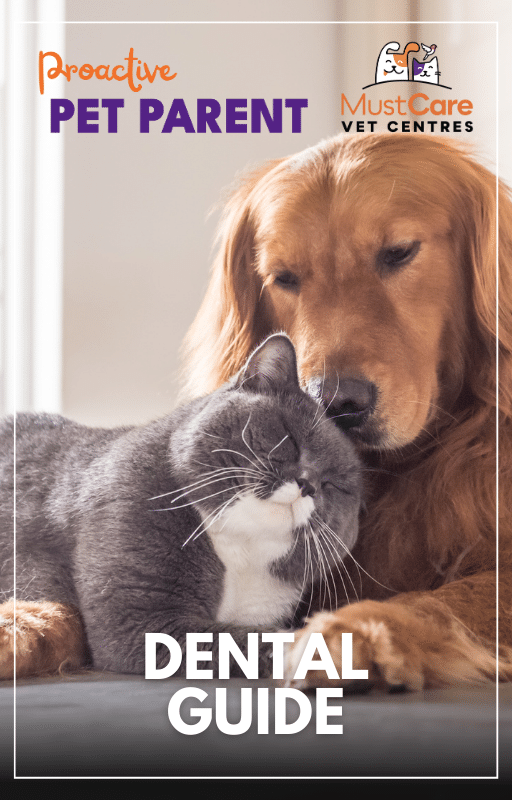Share This Blog With Other Pet Parents!
Combating Yeast Infections in Dogs & Cats
Affecting both dogs and cats, yeast infections can turn your pet’s peaceful life into a constant battle against itchiness and irritation. Understanding the differences between ear mites, yeast infections, and bacterial infections is crucial for any pet owner.
This article delves into the signs, treatments, and preventive measures for yeast infections in pets. With expert advice and practical tips, we aim to empower pet owners to take proactive steps in ensuring their pets’ ears remain healthy, comfortable, and infection-free.
What you’ll learn from this blog:

For all you need to know, download our
FREE Dental Guide
This blog is part of our Proactive Pet Parent series! This is just the beginning… To see more blogs, click here! Better yet, sign-up to our newsletter to receive these directly to your inbox each month.
Sign-up To The Proactive Pet Parent Newsletter
Signs and Symptoms of Yeast Infections
Unlike other ear conditions that may present similar symptoms, yeast infections have distinct signs. Pets suffering from yeast infections often exhibit excessive scratching of the ears, head shaking, and rubbing their ears against furniture or the floor. This behavior is a clear indicator of discomfort or irritation within the ear canal.
You might also notice an unusual odor emanating from the ears, a common hallmark of a yeast overgrowth. The ears may also appear red and swollen, with a noticeable discharge that can range from yellowish to a brownish-black color, often described as resembling coffee grounds. This discharge is a mixture of wax, yeast, and other debris accumulated in the ear canal.
Another significant symptom to look out for is a change in the skin’s condition around the ear, which may become thickened or darkened, indicating a chronic problem. It’s very important for pet owners to be aware of these signs, as early detection can prevent the infection from worsening and ensure a quicker recovery for their pet.
Causes of Yeast Infections in Pets
Yeast infections in pets stem from a disruption in the natural balance of the ear’s environment, leading to an overgrowth of yeast. Several factors contribute to this imbalance, making it crucial for pet owners to understand the underlying causes to prevent future infections.
Causes include:
- Moisture creates an ideal breeding ground for yeast. Pets who swim frequently or are bathed without properly drying their ears are at higher risk.
- Allergies, whether to food, environmental factors, or flea bites, can also lead to yeast infections by causing inflammation and an altered skin condition that favours yeast growth.
- Underlying health conditions, such as hormonal imbalances or autoimmune diseases, can predispose pets to yeast overgrowths by compromising the skin’s natural defences.
- Improper cleaning of the ears, which can push debris further into the ear canal, creating a blockage and a moist environment where yeast can thrive.
Diagnosis and Professional Care
Identifying your pets ear troubles involves more than just recognising symptoms at home. A veterinarian’s diagnosis is essential to differentiate between yeast infections and other ear problems, such as mites or bacterial infections.
Veterinarians typically begin with a thorough examination of the pet’s ear, using an otoscope to look deep into the ear canal for signs of inflammation, discharge, and the presence of yeast organisms. They may also take samples of the ear discharge to examine under a microscope, confirming the presence of yeast versus bacteria or other parasites. This step is crucial as it determines the specific treatment plan, tailored to address the yeast infection effectively.
In some cases, further diagnostic tests might be required to identify underlying conditions contributing to the infection, such as allergies or hormonal imbalances.
Treatment Options for Yeast Infections
Treating yeast infections in pets involves a multifaceted approach to eliminate the overgrowth and address any underlying conditions. Based on the diagnosis, veterinarians typically prescribe topical antifungal medications applied directly to the affected ear. These medications help to reduce the yeast population and alleviate symptoms of itching and inflammation.
In more severe cases, oral antifungal agents may be necessary to tackle the infection systemically. It’s also common for treatment plans to include ear cleaners that help maintain a clean and dry ear environment, discouraging yeast growth.
Alongside medical treatments, adjustments to the pet’s diet and environment may be recommended to prevent recurrence. For instance, incorporating foods with natural antifungal properties or supplements that support skin health can be beneficial.
You will play a crucial role in the treatment process by consistently applying medications, following through with dietary changes, and ensuring the pet’s living conditions support recovery. Your veterinarian will discuss regular follow-up visits which are essential to monitor your pet’s progress and make any necessary adjustments to the treatment plan.
Managing Ear Health
Active management of ear health is essential in keeping pets happy and free from discomfort. There are some things you can do to help maintain your pet’s condition:
- Regular inspections of the pet’s ears for signs of redness, odor, or discharge can help owners catch potential issues early before they develop into more serious conditions.
- When cleaning the ears, it’s important to use a gentle, veterinarian-recommended ear cleaner and to avoid inserting cotton swabs deep into the ear canal, as this can push debris further in and cause damage. Instead, focus on cleaning the outer ear and the part of the canal you can easily see.
Incorporate a routine ear cleaning schedule, as advised by a veterinarian to prevent the buildup of wax and debris that often leads to infections. - A well-balanced diet supports the immune system and can help prevent allergies that cause ear issues.
- Keeping pets well-groomed, especially those with long hair around the ears, can improve air circulation and reduce the risk of infections.
By taking these proactive steps, owners can maintain their pet’s ear health, ensuring a quality life free from the discomfort of ear conditions.

